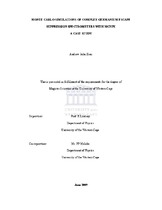| dc.contributor.advisor | Lindsay, Robbie | |
| dc.contributor.advisor | Maleka, Peane | |
| dc.contributor.author | Esau, Andrew John | |
| dc.contributor.other | NULL | |
| dc.contributor.other | Faculty of Science | |
| dc.date.accessioned | 2014-02-05T08:21:14Z | |
| dc.date.available | 2010/06/13 20:23 | |
| dc.date.available | 2010/06/13 | |
| dc.date.available | 2014-02-05T08:21:14Z | |
| dc.date.issued | 2009 | |
| dc.identifier.uri | http://hdl.handle.net/11394/2711 | |
| dc.description | Magister Scientiae - MSc | en_US |
| dc.description.abstract | Gamma ray spectroscopy has provided enormous amounts of information on the behaviour and structure of atomic nuclei [SHA88, BEA92, EBE08]. Most of the major discoveries in experimental nuclear physics over the last five decades are strongly associated with improvements in detector technologies. Inorganic scintilators led to the discovery in 1963 of the first excited states of a rotational band based on the ground state of 162Dy. Improvements in peak-to-background ratios and detector resolutions obtained with germanium led to the first evidence of backbending which is associated with a two quasi-particle excitation in 162Dy [SHA88]. More recently the development of composite and highly-segmented Ge detectors has significantly increased the performance and power of detection systems. The Clover detector is such a detector system and is in use at iThemba LABS. This study concerns the evaluation of the particle transport code MCNPX 2.5.0 as a tool to model complex composite detectors such as the Clover. Lanthanum silicate (LSO) and Lead tungstate (PbWO) are also evaluated as possible suppressor shield materials. It is shown that reasonable agreement between experiment and simulation is found when the experiment is accurately reproduced. However, when complex detection modes are implemented in the detector based on the number of elements that fire, MCNPX cannot be used to model the detector performance exactly. Differences between simulated and experimental results are found in suppressed add-back mode. It is proposed that the discrepancies are due to limitations in implementation of the pulse-height and special anti-coincidence tally in MCNPX. LSO and PbWO are compared to BGO as suppressor shield materials. It is found that LSO is not an ideal material for a suppression shield. PbWO is shown to give performance values similar to that of BGO. The back-plug is shown to have no effect on the Peak-to-Total ratio but is effective at reducing the background at lower energies. | en_US |
| dc.language.iso | en | en_US |
| dc.publisher | University of the Western Cape | en_US |
| dc.subject | Gamma-rays | en_US |
| dc.subject | Gamma ray spectroscopy | en_US |
| dc.subject | MCNPX | en_US |
| dc.title | Monte carlo simulations of complex germanium escape suppression spectrometers with MCNPX a case study | en_US |
| dc.type | Thesis | en_US |
| dc.rights.holder | University of the Western Cape | en_US |
| dc.description.country | South Africa | |

